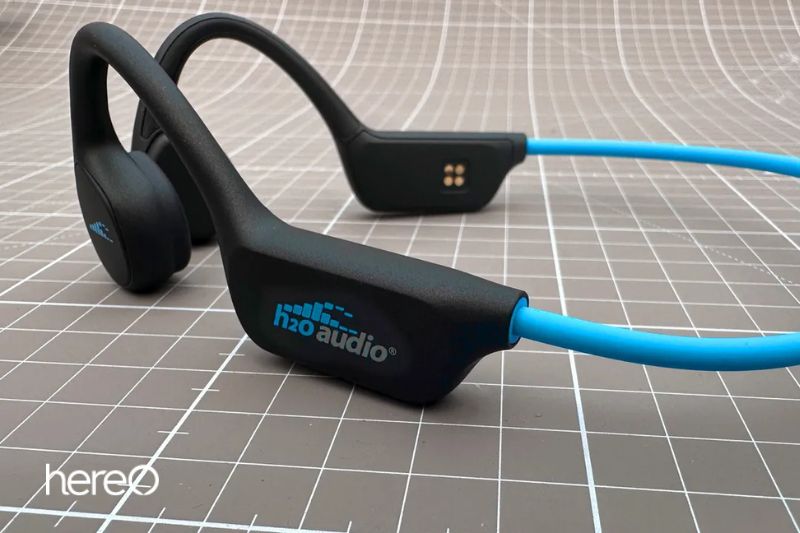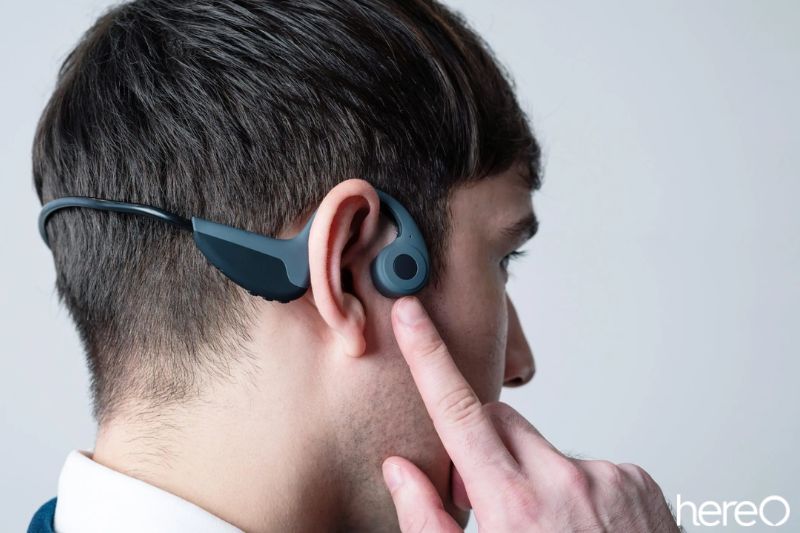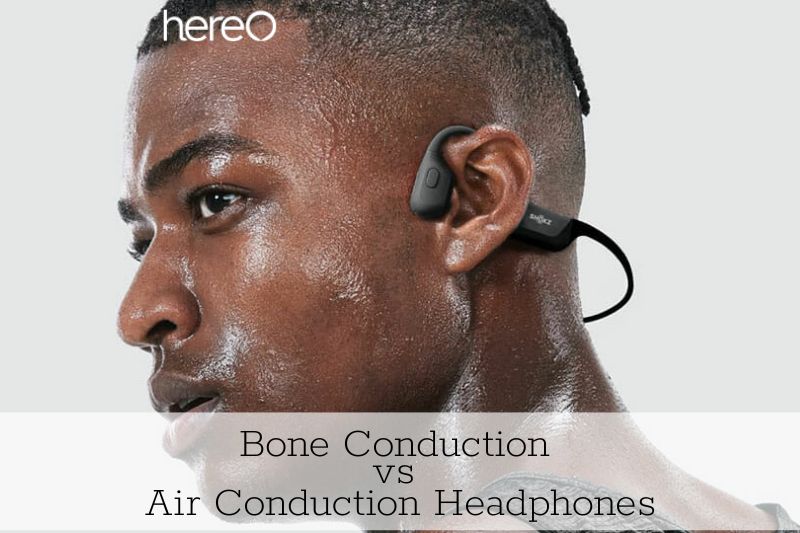Bone conduction is something you might be interested in if you enjoy having cutting-edge audio equipment, but it differs from air conduction in several ways. Before you buy a brand new bone conduction headphones, let us show you the difference between bone conduction vs air conduction headphones.
Contents
What is Air Conduction?

Air conduction is the traditional way of auditory sound transmission. It involves the transfer of sound energy from the air to the inner ear.
The sound waves that enter the ear via air conduction do so through the air. Sound waves are funneled via the outer ear and ultimately end up at the eardrum. Sound waves cause the eardrum to vibrate, and these vibrations travel through the middle ear’s small bones.
The cochlea, an inner ear structure filled with fluid, receives the vibrations after being amplified by the middle ear bones.
What is Bone Conduction?

Bone conduction technology works by sending sound waves through the bones of a user’s skull rather than their ear canal.
The sound waves vibrate the bones in the skull, which amplifies the sound and allows it to be heard. While this technology provides a unique listening experience, it is not as effective at delivering stereo imaging as traditional earbuds.
This idea underlies bone conduction hearing aids, which avoid middle ear issues by sending a clean signal to the inner ear.
This kind of hearing aid is very helpful for people who suffer from certain hearing losses, such as those brought on by harm to the eardrum or middle ear bones.
Bone Conduction Headphones
An example of an audio device that transmits sound waves directly to the inner ear is a pair of bone conduction headphones. They are the ideal option for anyone seeking an alternative to conventional headphones because of this.
Many consumers find bone conduction headphones to be an appealing alternative due to a few main advantages.
First off, they may be more comfortable to use for longer periods of time as they don’t rely on earbuds or ear cups. Second, they don’t completely block out outside noise, which in some circumstances may be advantageous.
Bone Conduction vs Air Conduction Headphones

Audio Quality
Even while bones have many uses, hearing is scarcely one of them. The ossicles may be the exception, but even they could function just as well if they were constructed of a different substance. If you give it some thought, the ossicles don’t contribute to bone conduction.
All of this is to suggest that you shouldn’t anticipate bone conduction headphones to provide audio quality that is even remotely close to that of conventional headphones because bones are ineffective for this purpose.
Even the greatest models can’t match the audio quality of entry-level in-ear headphones, while some models do offer greater audio quality than others.
Sound Leakage
The ability to be aware of surroundings is one of the key advantages of utilizing bone-conduction headphones for sports.
But because they do exhibit audible sound leaking, you might want to reconsider utilizing them in quiet areas.
Fit and Comfort
In general, you shouldn’t ever experience a bone conduction headphone fitting issue.
Bone conduction headphones lay on your cheekbones as opposed to in-ear devices, where you might not have the proper ear tips, or over-ear models, which might cause ear perspiration or irritation.
When discussing headphones, the phrase “you’ll forget you’re even wearing them” is frequently used, however in this case, it can be taken fairly literally. Remember, these cheekpieces have to vibrate against your cheekbones even when they are not in use.
These vibrations shouldn’t be audible at moderate volumes, but as the volume increases, the vibrations become more obtrusive and annoying.
Advantages and Disadvantages of Bone Conduction

Advantages of Bone Conduction Headphones
Listen with Open Ears
The most lauded benefit of bone conduction headphones is “open ear listening,” which eliminates the need to cover the ears or block the ear canal in order to achieve the same goal as traditional earphones.
This is because the principle of bone conduction states that bone conduction sports earphones do not need to transmit sound through the ear canal.
When wearing bone conduction headphones, you can hear the sounds around you as well as the music you’re listening to.
This prevents users from becoming “earblind” while exercising, especially when participating in outdoor activities. The most prestigious benefit of bone conduction headphones is also the emergence of hazardous scenarios.
Comfortability and Hygiene
Bone conduction headphones can maintain the interior of the ear canal clean and hygienic because they do not require earplugs in human ears. In contrast to conventional air conduction earphones, which are prone to bacterial buildup, bone conduction earphones have a smooth, clean surface.
On the other hand, conventional earbuds frequently need the insertion of earplugs into the ear canal. Bacteria will eventually proliferate since the air in the ear is blocked, sweat is secreted, and cleaning the housing is difficult. In extreme circumstances, it can lead to ear conditions like otitis or otitis media.
Waterproof
The latest generation of bone conduction headphones can be completely sealed with no openings, but in-ear headphones cannot because the speaker’s sound quality will be significantly diminished.
Because of their improved waterproof capabilities, bone conduction headphones are waterproof and can even be used while swimming. Certain in-ear sports headphones from reputable manufacturers like mifo, Jabra, and JBL can, of course, also be waterproof to the submersible level.
However, this only applies to technologies like waterproof earmuffs and material waterproof coating. The complexity and expense of these two processes will significantly grow.
Disadvantages of Bone Conduction Headphones
Lower Sound Quality
The primary use of bone conduction headphones has always been as “sports headphones,” which not only demonstrates their benefits in sporting events but also demonstrates that their sound quality falls short of those of headphones used for regular listening.
Problem with Sound Leakage
The issue of sound leakage is one that affects bone conduction headphones frequently. The phenomena of sound leakage still occurs in bone conduction headphones, although the sound leakage situation is worse than previously, despite the fact that major manufacturers are now working hard to enhance the lack of sound leakage of bone conduction headphones.
It’s okay to periodically listen to music in a peaceful setting.
Which Is Better For You – Bone Conduction vs Air Conduction Headphones
Ultimately, the choice between bone conduction and air conduction headphones comes down to your own needs.
For listening to music and secluded listening, air conduction headphones are preferable. Open-back headphones can also be used if you desire the audio quality but not the isolation.
The ability to stay aware of your surroundings using bone conduction headphones is unmatched, but the audio quality is at best poor. If you have conductive hearing loss, bone conduction headphones are also fantastic, but you should always seek the advice of a professional for a more long-term solution.
FAQs about Bone Conduction vs Air Conduction Headphones

Can you use bone conduction headphones tinnitus problem?
Traditional earphones are generally disliked by those who have tinnitus because they cancel out outside noise, making the condition worse. By using sound as a type of tinnitus distraction and relaxation, bone conduction technology allows you to hear the environment around you without losing your ability to hear.
Why do people use bone conduction headphones?
Users are able to listen to device audio while keeping their ears free because when in use, the bones in their skull vibrate to magnify the sound waves. People who need to utilize their ears to keep aware of their surroundings, such as those with hearing impairments, will benefit from this.
Can you hear outside noise with bone conduction headphones?
The ear canal is left unblocked and the eardrum is not affected by sound waves because the headphones rest on your cheekbones. The end result is a novel method of music listening that preserves your ability to perceive background noise without distorting the sound or obstructing your ear canals.
Conclusion
Whether you’re a tech enthusiast or an audiophile, bone conduction headphones are an innovative form of audio technology that can open up a new world of sound. It’s important to understand the differences between bone conduction and air conduction before making your purchase.
Thank you for reading this article from hereOfamily.
